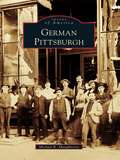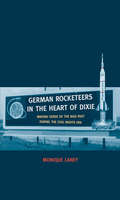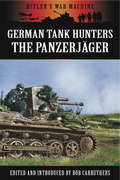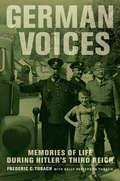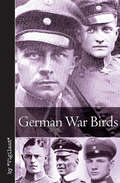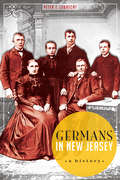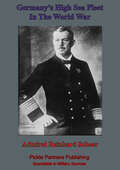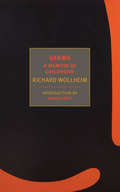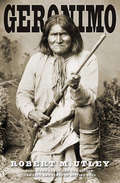- Table View
- List View
German Boy: A Refugee’s Story (Willie Morris Books in Memoir and Biography)
by Colonel Wolfgang W. SamuelWhat was the experience of war for a child in bombed and ravaged Germany? In this memoir, the voice of innocence is heard. “This is great stuff,” exclaims Stephen E. Ambrose. “I love this book.” In this gripping account, a boy and his mother are wrenched from their tranquil lives to forge a path through the storm of war and the rubble of its aftermath. In the past there has been a spectrum of books and films that share other German World War II experiences. However, told from the perspective of a ten-year-old, this book is rare. The boy and his mother must prevail over hunger and despair, or die. In the Third Reich, young Wolfgang Samuel and his family are content but alone. The father, a Luftwaffe officer, is away fighting the Allies in the West. In 1945 as Berlin and nearby communities crumble, young Wolfgang, his mother Hedy, and little sister Ingrid flee the advancing Russian army. They have no inkling of the chaos ahead. In Strasburg, a small town north of Berlin where they find refuge, Wolfgang begins to comprehend the evils the Nazi regime brought to Germany. As the Reich collapses, mother, son, and daughter flee again just ahead of the Russian charge. In the chaos of defeat they struggle to find food and shelter. Death stalks the primitive camps that are their temporary havens, and the child becomes the family provider. Under the crushing responsibility, Wolfgang becomes his mother’s and sister’s mainstay. When they return to Strasburg, the Communists in control are as brutal as the Nazis. In the violent atmosphere of arbitrary arrest, rape, hunger, and fear, the boy and his mother persist. Pursued by Communist police through a fierce blizzard, they escape to the West, but even in the English zone, the constant search for food, warmth, and shelter dominates their lives, and the mother’s sacrifices become the boy’s nightmares. Although this is a time of deepest despair, Wolfgang hangs on to the thinnest thread of hope. In June 1948 with the arrival of the Americans flying the Berlin Airlift, Wolfgang begins a new journey.
German Chicago: Revisited (Images of America)
by Raymond LohneGerman Chicago Revisited follows the photographic study which began in German Chicago: The Danube Swabians and the American Aid Societies. With this latest title in the Images of America series, historian and photographer Raymond Lohne crafts another volume about a group of American citizens who preserve their rich heritage with unwavering effort.This book will give readers a glimpse into the life of a close-knit and highly active community, revealing groups like the Kerneir Pleasure Club, the American Aid Society, and the Society of the Danube Swabians. The German musical life of the city is featured, as is the Karneval season and other year-round festivities and celebrations of the Deutsch-Americans of Chicago and its suburbs.
German Chicago: The Danube Swabians and the American Aid Societies
by Raymond LohneIn German Chicago: The Danube Swabians and the American Aid Societies, historian Raymond Lohne presents the Germans who came to be called the Donauschwaben and their American counterparts. This amazing photographic collection of over 200 historic images has been gathered through the efforts of the author and survivors of the Expulsion, as well as numerous German-American societies and individuals throughout the nation.
German Influences in Louisville (American Heritage)
by C. Robert UllrichThe first German immigrants in Louisville were shoemakers, bakers, butchers, blacksmiths and brewers--literally everything from basket makers to carriage manufacturers. Later, these industrious immigrants became captains of industry and influence in the city. August Prante's family built many of the magnificent organs for Louisville churches. Abraham Flexner was a pioneer in medical education, while Louis Brandeis was the first Jew to serve on the United States Supreme Court. William George Stuber, the son of Louisville photographer Michael Stuber, became the president of the Eastman Kodak Company. C. Robert Ullrich and Victoria A. Ullrich present a series of essays detailing how German immigrants shaped the industry and culture of Louisville.
German Intellectuals and the Challenge of Democratic Renewal
by Sean A. FornerThis book examines how democracy was rethought in Germany in the wake of National Socialism, the Second World War and the Holocaust. Focusing on a diverse network of public intellectuals in the immediate post-war occupation years, Sean A. Forner traces their attempts to reckon with the experience of Nazism and scour Germany's ambivalent political and cultural traditions for materials with which to build a better future. In doing so, he reveals, they formulated an internally variegated but distinctly participatory vision of democratic renewal - a paradoxical counter-elitism of intellectual elites. Although their projects ran aground on internal tensions and on the Cold War, their commitments fuelled critique and dissent in East and West during the 1950s and thereafter. The book uncovers a conception of political participation that went beyond the limited possibilities of the Cold War era and which would influence the political struggles of later decades in both post-war Germanys.
German Military and the Weimar Republic: General Hans Von Seekt, General Erich Ludendorff And The Rise Of Hitler
by Karen SchaeferThis military biography examines the man who sought to rebuild the Germany Army after WWI—and the rival who stoked the rise of Nazism.After Germany’s devastating defeat in the First World War, General Hans von Seekt became Chief of the Army Command at the Reichewehr Ministry of the Weimar Republic. His job was to rebuild the shattered German army and repair the nation’s standing on the world stage. The punitive terms of the post-war settlement made these ambitious goals nearly impossible, but the most significant challenges von Seekt faced came from within Germany.Von Seekt aimed to build a modern and efficient military with a main strategy of peaceful defense purposes. This original and far-sighted policy was opposed by his rival, General Erich Ludendorff, who led a nationalistic movement seeking revenge for Germany’s defeat. Ludendorff proposed to rebuild the once-mighty German imperial army as a major international force. The failure of von Seekt's experiment was tragically mirrored by the fall of the Weimar Republic, and the rise of rise of Hitler and Nazi Germany.
German New York City (Images of America)
by Richard PanchykGerman New York City celebrates the rich cultural heritage of the hundreds of thousands of German immigrants who left the poverty and turmoil of 19th- and 20th-century Europe for the promise of a better life in the bustling American metropolis. German immigration to New York peaked during the 1850s and again during the 1880s, and by the end of the 19th century New York had the third-largest German-born population of any city worldwide. German immigrants established their new community in a downtown Manhattan neighborhood that became known as Kleindeutschland or Little Germany. During the late 19th and early 20th centuries, much of the German population moved north to the Upper East Side's Yorkville and subsequently spread out to the other boroughs of the city.
German Pittsburgh (Images of America)
by Michael R. ShaughnessyGerman Pittsburgh explores the multifaceted cultural history of German-speaking immigrants and residents in the Greater Pittsburgh area. Today over one quarter of the city's residents claim German heritage, the largest ethnic group in the region. German-speaking Pittsburghers include names like H. J. Heinz, Honus Wagner, and the Kaufmanns, and they produced beloved Pittsburgh beers such as Iron City and Penn Pilsner. It might be surprising to know that German was an official language of the city at one time, and a daily German newspaper was printed from the mid-1800s up through World War II. Today remnants of the German-speaking community can be found on the North Side, the South Side, Troy Hill, and Mount Oliver, to name a few. German Pittsburgh provides an overview of the contributions that this diverse ethnic community has made and is making today in the city.
German Rocketeers in the Heart of Dixie
by Dr Monique LaneyThis thought-provoking study by historian Monique Laney focuses on the U. S. government-assisted integration of German rocket specialists and their families into a small southern community soon after World War II. In 1950, Wernher von Braun and his team of rocket experts relocated to Huntsville, Alabama, a town that would celebrate the team, despite their essential role in the recent Nazi war effort, for their contributions to the U. S. Army missile program and later to NASA's space program. Based on oral histories, provided by members of the African American and Jewish communities, and by the rocketeers' families, co-workers, friends, and neighbors, Laney's book demonstrates how the histories of German Nazism and Jim Crow in the American South intertwine in narratives about the past. This is a critical reassessment of a singular time that links the Cold War, the Space Race, and the Civil Rights era while addressing important issues of transnational science and technology, and asking Americans to consider their country's own history of racism when reflecting on the Nazi past.
German Settlers of South Bend
by Gabrielle RobinsonThe story of the first German immigrants to northern Indiana is the story of the beginnings of South Bend. The predominant immigrant group from the 1840s to the 1870s, the Germans helped build South Bend from an isolated trading post into a thriving industrial city. They also played a key role in transforming the surrounding wilderness into rich and fertile farmland.Using first-hand personal accounts and public documents, German Settlers of South Bend illustrates the lives of these pioneer immigrants and their growing city. The material has been collected from a large number of sources on both sides of the Atlantic, including more than 200 German letters from the 1840s to the 1870s that provide glimpses into the day-to-day lives of these early settlers and their families back in Germany. Descendants of immigrants from all over the United States and Germany have come forward with genealogies, stories, and pictures, providing a far-reaching portrait of the times.
German Soldiers in the Great War: Letters and Eyewitness Accounts
by Jay Winter Benjamin Ziemann Bernd UlrichThe first English translation of writings that capture the lives and thoughts of German soldiers fighting in the trenches and on the battlefields of WWI. German Soldiers in the Great War is a vivid selection of firsthand accounts and other wartime documents that shed new light on the experiences of German frontline soldiers during the First World War. It reveals in authentic detail the perceptions and emotions of ordinary soldiers that have been covered up by the smokescreen of official military propaganda about “heroism” and “patriotic sacrifice.” In this essential collection of wartime correspondence, editors Benjamin Ziemann and Bernd Ulrich have gathered more than two hundred mostly archival documents, including letters, military dispatches and orders, extracts from diaries, newspaper articles and booklets, medical reports and photographs. This fascinating primary source material provides the first comprehensive insight into the German frontline experiences of the Great War, available in English for the first time in a translation by Christine Brocks.
German Students' War Letters
by Jay Winter A. F. Wedd Philipp WitkopOriginally appearing at the same time as the pacifist novel All Quiet on the Western Front, this powerful collection provides a glimpse into the hearts and minds of an enemy that had been thoroughly demonized by the Allied press. Composed by German students who had left their university studies in order to participate in World War I, these letters reveal the struggles and hardships that all soldiers face.The stark brutality and surrealism of war are revealed as young men from Germany describe their bitter combat and occasional camaraderie with soldiers from many nations, including France, Great Britain, and Russia. Like its companion volume, War Letters of Fallen Englishmen, these letters were carefully selected for their depth of perception, the intensity of their descriptions, and their messages to future generations. "Should these letters help towards the establishment of justice and better understanding between nations," the editor reflects in his introduction, "their deaths will not have been in vain." This edition contains a new foreword by the distinguished World War I historian Jay Winter.
German Tank Hunters: The Panzerjäger (Hitler's War Machine)
by Bob CarruthersThis unique collection of contemporary combat accounts provides a primary source insight into the reality of anti-tank warfare on the Eastern Front. Both armoured and infantry based operations are considered.This book is part of the 'Hitler's War Machine' series, a new military history range compiled and edited by Emmy Award winning author and historian Bob Carruthers. The series draws on primary sources and contemporary documents to provide a new insight into the true nature of Hitler's Wehrmacht.The series consultant is David Mcwhinnie creator of the award winning PBS series 'Battlefield'.
German Voices: Memories of Life during Hitler's Third Reich
by Sally Patterson Tubach Frederic C. TubachWhat was it like to grow up German during Hitler's Third Reich? In this extraordinary book, Frederic C. Tubach returns to the country of his roots to interview average Germans who, like him, came of age between 1933 and 1945. Tubach sets their recollections and his own memories into a broad historical overview of Nazism--a regime that shaped minds through persuasion (meetings, Nazi Party rallies, the 1936 Olympics, the new mass media of radio and film) and coercion (violence and political suppression). The voices of this long-overlooked population--ordinary people who were neither victims nor perpetrators--reveal the rich complexity of their attitudes and emotions. The book also presents selections from approximately 80,000 unpublished letters (now archived in Berlin) written during the war by civilians and German soldiers. Tubach powerfully provides new insights into Germany's most tragic years, offering a nuanced response to the abiding question of how a nation made the quantum leap from anti-Semitism to systematic genocide.
German War Birds (Vintage Aviation Library)
by Claude W. SykesDramatic true stories of air combat featuring Germany&’s greatest pilots: &“AWorld War I aviation history classic&” (Over the Front). In these riveting accounts, Manfred von Richthofen, Max Immelmann, Oswald Boelcke, and other famous daredevil flyers are joined by lesser-known but equally resourceful colleagues such as Rudolf von Eschwege and Hans Schüz as they take part in furious battles in the sky—and close escapes on the ground when brought down on the wrong side of the lines. German War Birds contains some of the earliest information to appear after the war about air combat in the Middle East and Russia, as well as the Western Front, and about the significance of observation balloons as targets that were viciously attacked. The author focuses on the heart of the action and recreates the experiences of the airborne war with immediacy and excitement—drawing the reader into events as they happen.
German, Jew, Muslim, Gay: The Life and Times of Hugo Marcus (Religion, Culture, and Public Life)
by Marc David BaerHugo Marcus (1880–1966) was a man of many names and many identities. Born a German Jew, he converted to Islam and took the name Hamid, becoming one of the most prominent Muslims in Germany prior to World War II. He was renamed Israel by the Nazis and sent to the Sachsenhausen concentration camp before escaping to Switzerland. He was a gay man who never called himself gay but fought for homosexual rights and wrote queer fiction under the pen name Hans Alienus during his decades of exile.In German, Jew, Muslim, Gay, Marc David Baer uses Marcus’s life and work to shed new light on a striking range of subjects, including German Jewish history and anti-Semitism, Islam in Europe, Muslim-Jewish relations, and the history of the gay rights struggle. Baer explores how Marcus created a unique synthesis of German, gay, and Muslim identity that positioned Johann Wolfgang von Goethe as an intellectual and spiritual model. Marcus’s life offers a new perspective on sexuality and on competing conceptions of gay identity in the multilayered world of interwar and postwar Europe. His unconventional story reveals new aspects of the interconnected histories of Jewish and Muslim individuals and communities, including Muslim responses to Nazism and Muslim experiences of the Holocaust. An intellectual biography of an exceptional yet little-known figure, German, Jew, Muslim, Gay illuminates the complexities of twentieth-century Europe’s religious, sexual, and cultural politics.
Germanicus: The Magnificent Life and Mysterious Death of Rome's Most Popular General
by Lindsay Powell&“The story of a Roman Emperor that might have been&” (Fighting Times). Germanicus was regarded by many Romans as a hero in the mold of Alexander the Great. His untimely death, in suspicious circumstances, ended the possibility of a return to a more open republic. This, the first modern biography of Germanicus, is in parts a growing-up story, a history of war, a tale of political intrigue, and a murder mystery. In this highly readable, fast paced account, historical detective Lindsay Powell details Germanicus&’s campaigns and battles in Illyricum and Germania; tracks him on his epic tour of the Eastern Mediterranean to Armenia and down the Nile; evaluates the possible causes of his death; and reports on the cruel fate his wife, Agrippina, and their children suffered at the hands of Praetorian Guard commander, and Tiberius&’s infamous deputy, Aelius Sejanus.
Germans in New Jersey: A History (American Heritage)
by Peter T. LubrechtGerman immigrants and their descendants are integral to New Jersey's history. When the state was young, they founded villages that are now well-established communities, such as Long Valley. Many German immigrants were lured by the freedom and opportunity in the Garden State, especially in the nineteenth century, as they escaped oppression and revolution. German heroes have played a patriotic part in the state's growth and include scholars, artists, war heroes and industrialists, such as John Roebling, the builder of the Brooklyn Bridge, and Thomas Nast, the father of the American cartoon. Despite these contributions, life in America was not always easy; they faced discrimination, especially during the world wars. But in the postwar era, refugees and German Americans alike--through their Deutsche clubs, festivals, societies and language schools--are a huge part of New Jersey's rich cultural tapestry.
Germany's High Sea Fleet In The World War (Barnes and Noble Digital Library)
by Anon. Admiral Reinhard ScheerIncludes 26 illustrations, battle maps and portraits of the Naval War 1914-1918Known to his own sailors as the "Man with the Iron Mask", Admiral Reinhard Scheer was a hardened dedicated sailor. It was his relentless drive that enabled him to overcome his limited social background and gain the highest rank in the Kaiserliche Marine. His memoirs are of great interest to historians of the First World War and the nascent German 'Great Power' status.Broadly divided into three sections, the first part of his memoirs concentrates on the German Fleet's activities during the first years of the war, including the bombardment of the coast of Britain, which came as such a shock to the Allies. The second, which naturally dominates his memoirs, are his great exploits at the Battle of Jutland or Skaggerak in command of the cruiser squadron which caused such damage to the British Fleet. The third and final part recounts his time as chief of staff of the German Navy, as an advocate of unrestricted Naval Warfare he recounts his lobbying of the Emperor and the methods and experiences of the U-Boats under his command.A thoroughly gripping Naval read.Author -- Admiral Reinhard Scheer (1863-1928)Translator -- Anon.Text taken, whole and complete, from the edition published in New York [etc.] Cassell and company, ltd., 1920.Original Page Count - xiv and 375 pages.
Germs: A Memoir of Childhood (G - Reference,information And Interdisciplinary Subjects Ser.)
by Richard WollheimA brilliant, meandering exploration of family and childhood memory by one of the most original British philosophers of the twentieth century.Germs is about first things, the seeds from which a life grows, as well as about the illnesses it incurs, the damage it sustains. Written at the end of the life of Richard Wollheim, a major British philosopher of the second half of the twentieth century, this memoir is not the usual story of growing up, but very much about childhood, that early world we all share in which we do not not know either the world or ourselves for sure, and in which things--houses, clothes, meals, parents, the past--loom large around us, seeming both inevitable and uncontrollable. Richard Wollheim's remarkable, moving, and entirely original book recovers this formative moment that makes us who we are before we really are who we are and that haunts us all our lives in lucid and lyrical prose.
Geronimo
by Meryl Henderson George E. StanleyIn this illustrated biography, young Apache Goyahkla and his friend play games in their village that will prepare him for his role as a hunter and warrior--and the place he will hold in history as Geronimo, fighter for the rights of his people.
Geronimo
by GeronimoEnter the world of Geronimo Stilton, where another funny adventure is always right around the corner. Each book is a fast-paced adventure with lively art and a unique format kids 7-10 will love. Ah, there's nothing like a relaxing vacation on the beach! I would spread out by the crystal-clear water with a good book. What more could a mouse want? At least, that was the plan. But somehow, my vacations never seem to go according to plan. Instead of a beautiful seaside resort, I found myself in a fleabag hotel that was falling down around my ears! Oh, would I ever be able to relax and enjoy my vacation??
Geronimo (Cornerstones of Freedom)
by Zachary KentA biography of the Apache warrior who led attacks on settlers and soldiers in Mexico and the Southwestern United States during the 1870s and 1880s.
Geronimo (The Lamar Series in Western History)
by Robert M. UtleyThis &“meticulous and finely researched&” biography tracks the Apache raider&’s life from infamous renegade to permanent prisoner of war (Publishers Weekly). Notorious for his ferocity in battle and uncanny ability to elude capture, the Apache fighter Geronimo became a legend in his own time and remains an iconic figure of the nineteenth century American West. In Geronimo, renowned historian Robert M. Utley digs beneath the myths and rumors to produce an authentic and thoroughly researched portrait of the man whose unique talents and human shortcomings swept him into the fierce storms of history. Utley draws on an array of newly available sources, including firsthand accounts and military reports, as well as his geographical expertise and deep knowledge of the conflicts between whites and Native Americans. This highly accurate and vivid narrative unfolds through the alternating perspectives of whites and Apaches, arriving at a more nuanced understanding of Geronimo&’s character and motivation than ever before. What was it like to be an Apache fighter-in-training? Why was Geronimo feared by whites and Apaches alike? Why did he finally surrender after remaining free for so long? The answers to these and many other questions fill the pages of this authoritative volume.







